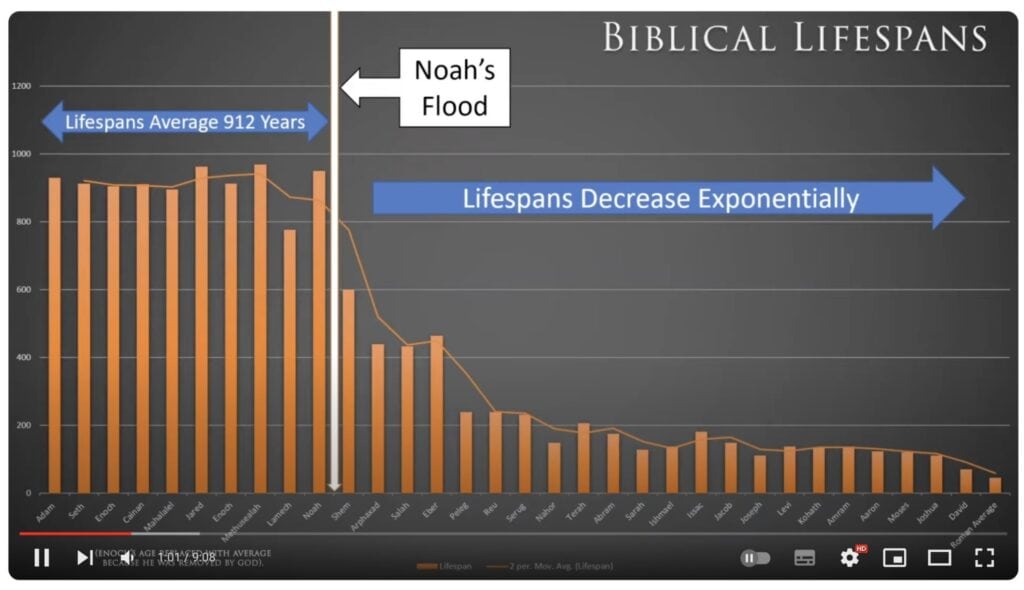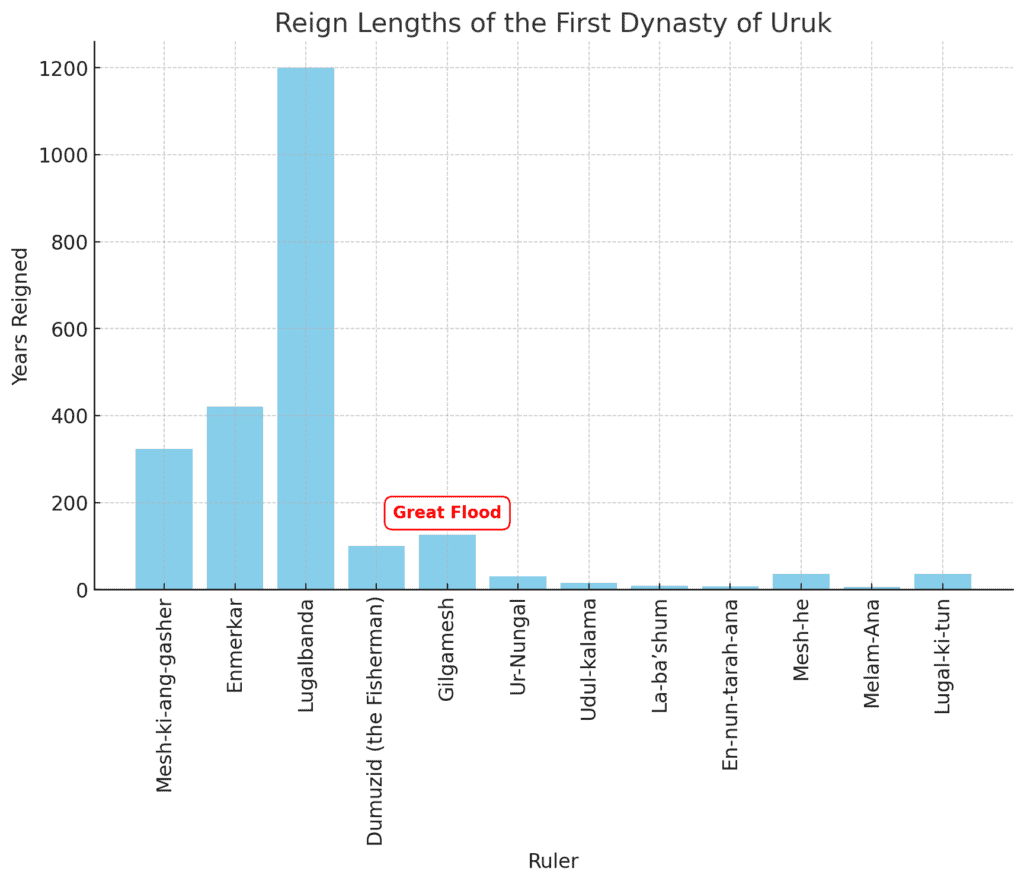Table of Contents
- Sumerian Kings List
- Turin King list
- The Book of the Heavenly Luminaries
- The genealogy from Adam
- Revelation 20
- Zoroastrian Yima
- Adam and 1000 years
- Shedd-Ad-Ben-Ad
- Neanderthals and Homo erectus had lifespans averaging around 30 to 40 years.
- Creation and Flood stories
- Athrahasis
- Lost advanced civilizations theory
In Genesis lifespan decreases after the deluge. Before the flood some people lived for several hundred years

While the Bible provides a religious explanation for this change, from a historical and scientific perspective, several theories have been proposed to explain the decrease in lifespan after the flood.
And the LORD said, My spirit appearance shall not always strive with man, for that he also is flesh: yet his days shall be limited to 120 years.
Genesis 6:3
Sumerian Kings List

Turin King list
In the Turin King List, the figure connected with the Great Flood is Zep Tepi, also known as the “First Time.” This term doesn’t correspond to a single king but rather to a mythical epoch in ancient Egyptian chronology that is said to have preceded the Great Flood. However, in Sumerian and Babylonian traditions, which often intertwine with Egyptian ones in the study of ancient Near Eastern history, the figure of Utnapishtim (also known as Ziusudra in Sumerian or Atrahasis in Akkadian) is the equivalent of Noah and is directly connected to the Great Flood myth.
| King or God | Years of Reign | Before or After Zep Tepi |
|---|---|---|
| Ra (Re) | Mythical | Before |
| Shu | Mythical | Before |
| Geb | Mythical | Before |
| Osiris | Mythical | Before |
| Seth | Mythical | Before |
| Horus | Mythical | Before |
| Narmer (Menes) | 62 years (approx.) | After |
| Hor-Aha | 60 years (approx.) | After |
| Djer | 41 years (approx.) | After |
| Djet | 10 years (approx.) | After |
| Den | 50 years (approx.) | After |
| Anedjib | 14 years (approx.) | After |
- Before Zep Tepi: This period is dominated by mythological gods who are considered to have ruled Egypt before the historical period began.
- After Zep Tepi: This period marks the beginning of historical kingship in Egypt, starting with the First Dynasty. The reign lengths for these kings are based on historical records and estimates.
After these things, when the rulers had become jealous of Adam, they wanted to diminish the human lifetimes, but they were unable because of fate, which was established since the beginning.
For their lifetimes were determined: for each of the people one thousand years according to the circuit of the luminaries. But although the rulers were not able to do this, each of the evildoers took away ten years.
So all of the remaining time amounts to nine hundred thirty years, and these are spent in grief and weakness and in evil distractions. Thus life has gone, from that day until the consummation of the age.
Nag Hammadi Code
The Book of the Heavenly Luminaries

https://www.ccel.org/c/charles/otpseudepig/enoch/ENOCH_3.HTM
The genealogy from Adam
The genealogy from Adam (the first man, according to the Bible) to Noah is as follows:
- Adam lived for 930 years.
- Seth, Adam’s son, lived for 912 years.
- Enosh, Seth’s son, lived for 905 years.
- Kenan, Enosh’s son, lived for 910 years.
- Mahalalel, Kenan’s son, lived for 895 years.
- Jared, Mahalalel’s son, lived for 962 years.
- Enoch, Jared’s son, lived for 365 years.
- Methuselah, Enoch’s son, lived for 969 years.
- Lamech, Methuselah’s son, lived for 777 years.
- Noah, Lamech’s son, lived for 950 years.
The flood is said to have occurred in Noah’s 600th year. If you add up the ages, starting with the birth of Adam to the birth of Noah, and then add Noah’s age at the time of the flood (600 years), the total time from the Garden of Eden to the flood is:
930+912+905+910+895+962+365+969+777+600 = 8,225 years.
Revelation 20
The reference to a thousand-year period in the Book of Revelation, commonly known as the “Millennium,” is found in Revelation 20:1-6. Here’s the passage:
Revelation 20:1-6 (New International Version)
- And I saw an angel coming down out of heaven, having the key to the Abyss and holding in his hand a great chain.
- He seized the dragon, that ancient serpent, who is the devil, or Satan, and bound him for a thousand years.
- He threw him into the Abyss, and locked and sealed it over him, to keep him from deceiving the nations anymore until the thousand years were ended. After that, he must be set free for a short time.
- I saw thrones on which were seated those who had been given authority to judge. And I saw the souls of those who had been beheaded because of their testimony about Jesus and because of the word of God. They had not worshiped the beast or its image and had not received its mark on their foreheads or their hands. They came to life and reigned with Christ a thousand years.
- (The rest of the dead did not come to life until the thousand years were ended.) This is the first resurrection.
- Blessed and holy are those who share in the first resurrection. The second death has no power over them, but they will be priests of God and of Christ and will reign with him for a thousand years.
This passage describes the binding of Satan and the reign of Christ with his followers for a thousand years, an event that occurs at the end of time according to Christian eschatology.
…some find a link between the genealogy descended from Cain (Gen 4:17–22) and that from Seth (5:6–32). Both lists end with a figure named Lamech (Heb. למך, lemek), and the contrast between them is stark. The first Lamech had taken God’s assurance of sevenfold vengeance on anyone who kills Cain (4:15) and multiplied it by eleven for even a blow—that is, vengeance was no longer in God’s hands, and it was fiercer (4:23–24). The Hebrew for “seventy-sevenfold” is שׁבעים ושׁבעה [shib‘im weshib‘ah], “seventy and seven” (4:24). In 5:31 the second Lamech’s lifespan is 111 times seven years; in Hebrew, שׁבע שׁבעים שׁנה ושׁבע מאות שׁנה [sheba‘ shib‘im shanah usheba‘ me’ot shanah], “seven and seventy years and seven hundred years.” The 77 part comes first, in opposite order to that in 4:24. The first Lamech speaks bluster and threat; the second Lamech speaks hope and faith. The first embraces humans’ descent into sin and departure from God; the second bemoans it and looks for the gracious act of God. Rhetorically, the contrast enlists the audience to approve of the second and to side with him so that they can be loyal to God’s purpose through Noah—of whom Abram, and thus Israel, are the proper heirs.
JONATHAN MCLATCHIE
Zoroastrian Yima
Yima, according to Yt9.10, made immortality reign on the earth for a thousand years. The remaining century was spent in the Vara (‘for a hundred years, Jim was in the Var,’ says the Gr. Bund.) On Yima’s fall, see Yt19.34; see Yt5.25-31.
Adam and 1000 years
The body of Adam was so great, that if he stood up his head would reach into the seventh heaven. But he was not as yet endowed with a living soul.
The soul had been made a thousand years before, and had been steeped all that while in the sea of light which flowed from Allah.
God now ordered the soul to enter the body.
It showed some indisposition to obey; thereupon God exclaimed: “Quicken Adam against your will, and, as a penalty for your disobedience, you shall leave the body sorely against your will.”
Then God blew the spirit against Adam with such force that it entered his nose, and ran up into his head, and as soon as it reached his eyes Adam opened them, and saw the throne of God with the inscription upon it: “There is no God but God, and Mohammed is His prophet.” Then the soul ran into his ears, and Adam heard the song of the angels; thereupon his tongue was unloosed, for by this time the soul had reached it, and he said, “Praise be to Thee, my Creator, one and only!” And God answered him: “For this purpose are you made. You and your successors must pray to me, and you will find mercy and loving-kindness at my hands.” Then the soul penetrated all the members, reaching last of all the feet of Adam, which receiving strength, he sprang up, and stood upon the earth. But when he stood upright he was obliged to close his eyes, for the light of God’s throne shining directly into them blinded them. “What light is this?” he asked, as he covered his eyes with one hand, and indicated the throne with the other. “It is the light of a prophet,” God answered, “who will spring from thee in later ages. By mine honour I swear, for him alone have I created the world. In heaven he bears the name of the much-lauded, and on earth he will be called Mohammed. Through him all men will be led out of error into the way of truth.”
II.ADAM I. THE CREATION OF MAN.
At the seventh hour, Adam married Eve; at the eighth, Cain and his sister were born; at the ninth, they were forbidden to eat of the tree; at the tenth hour Adam fell; at the eleventh he was banished from Eden; and at the twelfth, he felt the sweat and pain of toil.
7 -> Adam married Eve
8 -> Cain and his sister were born
9 -> They were forbidden to eat of the tree
10 -> Adam fell
11 -> He was banished from Eden
12 -> He felt the sweat and pain of toil
Finally, when Adam had reached his nine hundred and thirtieth year, the Angel of Death appeared under the form of a goat, and ran between his legs.
Adam recoiled with horror, and exclaimed, “God has given me one thousand years; wherefore comest thou now?”
“What!” exclaimed the Angel of Death, “hast thou not given seventy years of thy life to the prophet David?“
Adam stoutly denied that he had done so. Then the Angel of Death drew the document of transfer from out of his beard, and presented it to Adam, who could no longer refuse to go.
The legends of Old Testament


Shedd-Ad-Ben-Ad
A great antediluvian king associated with Atlantis. Ad married many wives, had numerous descendants, and lived for 1200 years. His sons, Shadid and Shedad, succeeded him, with Shedad becoming a notable conqueror, said to have subdued all of Arabia and parts of Syria and Egypt.
Neanderthals and Homo erectus had lifespans averaging around 30 to 40 years.
In the field of paleoanthropology, which studies human evolution, researchers primarily rely on fossil evidence and ancient remains to understand the lifespans of early humans. While there is no direct method to determine the exact lifespan of ancient humans, scientists use various techniques and indicators to estimate their longevity.
One common method is the analysis of teeth. By studying dental wear patterns, growth rates, and the presence of dental diseases, scientists can make inferences about the general health and diet of ancient humans. Additionally, the study of skeletal remains can provide insights into overall health, the presence of diseases, and signs of aging.
One notable example of early human longevity comes from the remains of Homo neanderthalensis, commonly known as Neanderthals. Neanderthals were a distinct human species that lived in Europe and parts of Asia until about 40,000 years ago. Studies of Neanderthal remains suggest that they often lived to be around 30 to 40 years old, although some individuals could reach older ages. While this might seem short by modern standards, it was relatively long given the challenges and risks present in their environment.

Additionally, research on Homo erectus, an early human species that lived around 1.9 million to 70,000 years ago, provides some insights into their lifespan. Based on fossil evidence and studies of ancient environments, scientists estimate that Homo erectus individuals also had lifespans averaging around 30 to 40 years.
It’s important to note that these estimates are based on available evidence and can vary among different populations and regions. Early humans faced various challenges, such as predation, diseases, and environmental hardships, which could have influenced their lifespans. While these studies provide valuable information, the exact lifespans of early humans remain a topic of ongoing research and discussion in the scientific community.
Creation and Flood stories
Athrahasis
The Atrahasis is an ancient Mesopotamian epic that contains a creation myth as well as a flood story. In the creation myth part of the epic, the gods create humans to be their servants. The story involves a series of events where humans multiply rapidly and become noisy, disturbing the god Enlil’s sleep. In response, the gods first attempt to control the human population through drought, famine, and plague. When these measures fail to reduce the noise, the god Enlil decides to send a great flood to wipe out humanity.
Atrahasis, the protagonist of the story, is warned about the flood by the god Enki, who instructs him to build an ark to save himself, his family, and pairs of animals. Atrahasis follows Enki’s instructions, survives the flood, and later offers sacrifices to the gods. In the end, humans are recreated to continue serving the gods.
The version of the epic that has survived is fragmented, but it does contain mentions of certain numerical values. One notable reference is to the period of 3,600 years during which the gods imposed hard labor on the Igigi. The text describes how the gods bore the noise and toil of humanity for this lengthy span of time.
Additionally, there are references to 2 periods of 600 years and 3 epochs.
The epochs could represent cosmic cycles or divine eras.
If the gods described in Athrasis are extraterrestrial, then could it be that an epoch refers to a synodic period? A synodic period refers to the time it takes for a celestial body (like a planet) to return to the same apparent position relative to the Sun and Earth. For example, the synodic period of Mars is about 780 days, meaning that Mars appears in the same position in the night sky approximately every 780 days as observed from Earth.
The Anunnaki are a group of deities in ancient Mesopotamian cultures. They appear in Sumerian, Akkadian, Babylonian, and Assyrian myths, and are often depicted as a pantheon of gods and goddesses. Among the Anunnaki, two prominent figures are Enlil and Enki, who are considered major deities in the Sumerian pantheon.
Based on these years, the time between the creation story (creation of humans) and the flood is 12,000 years.
Based on the flood theory of Graham Hancock, a big flood happened around 10,500 BC, this put the creation of humans, not to be confused with the evolution of humans, at around 22,500 BCE.
This date corresponds with the recollection of past memories from Matias de Stefano, stating that the Aessir (Anunnaki) arrived around 20,000 BCE.
Lost advanced civilizations theory
The humans before the flood were no primitive hunter-gatherers, as is the mainstream theory. They were very skilled and connected with the earth’s chakras and the cosmos. Their knowledge of the universe and life was profound. The remains of this ancient civilization can be found in recollections of the time of Atlantis and Lemuria, and some highly advanced constructions that survived the flood. Examples are the Pyramid of Giza, Stonehenge, and Göbekli Tepe. While the first 2 are wrongly dated about 3,000 BCE. Gobekli Tepe, discovered in 1963, has been carbon dated at 9,500 BCE. What is odd about Goblike Tepe is that it was buried or covered, like the people at that time wanted it to protect for something that was coming.
